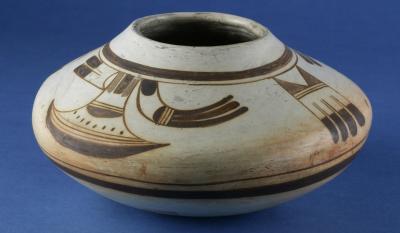
Bowl
Nampeyo, Hopi, United States
1902-1913
Size: H: 4.375 in. D: 8.75 in.
Gift of Reverend C.W. Douglas, 1929.77
Photograph © Denver Art Museum 2008. All Rights Reserved.
Nampeyo was one of the greatest ceramic artists of the 20th century and the first American Indian woman to make a name for herself as a potter outside her community. She was born around 1860 in the Hopi village of Hano. Although she didn’t start making pottery until her late teens, she continued to shape vessels up until her death in 1942, even after she lost her eyesight in about 1920 and was nearly blind. Her daughters Annie and Fannie helped by painting the pots in family patterns.
Nampeyo’s artistic legacy continues today. Her great-granddaughter Dextra Quotskuyva is well known for her contemporary forms of Hopi pottery, and at least nine other family members have artwork in the Denver Art Museum collection, including Dextra’s son Dan Namingha, a painter.
“When I first began to paint, I used to go to the ancient village and pick up pieces of pottery and copy the designs . . . But now I just close my eyes and see designs and I paint them.” – Nampeyo
By 1800, pottery production among the Hopi had almost disappeared. Forced by drought and epidemic to take temporary refuge at Zuni Pueblo, the Hopi relearned the art of pottery. Nampeyo at first worked in the Zuni style but soon became inspired by fragments of pottery that she found at ancient Hopi sites, including the ruins of Sikyatki. She developed her own personal style of painting, characterized by fluid strokes paired with fine-line decoration. From the prehistoric ware she adopted a range of subject matter but became best known for her designs composed of stylized bird wings and feathers.
Details

Cloud Bands
The lines that border the painted designs on the top and bottom of Nampeyo’s pot are also seen in historic Sikyatki pottery and are sometimes called “sky bands” or “cloud bands.”
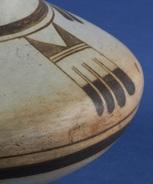
Eagle Tails
Nampeyo repeated the “eagle tail” motif throughout her career, and it has become one of the Nampeyo family designs

Stylized Bird and Kilt
The stylized bird design was one of the most frequently used decorative motifs on ancient Sikyatki vessels. Nampeyo adapted the motif and used it, with her own variations, on many of her pieces.
Below the bird, Nampeyo painted a design identified as a “stylized kilt,” which resembles Hopi ceremonial kilts.
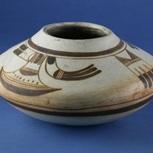
Shape
The bowl shape was most prevalent in Nampeyo’s work in the early 1900s. The bowl reaches its greatest width halfway between the top and bottom. The shoulders of the vessel are more sharply angled than in earlier pieces and culminate in a short neck and a small opening.
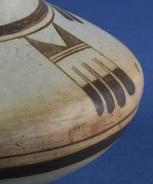
White Background
Nampeyo followed the Zuni style of painting her designs on coiled-clay vessels covered with a thick white slip (clay thinned with water that acts like a glaze when fired). She typically used brown or black paint, but at times she used yellow and red slip and also made unslipped vessels.
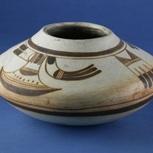
Tradition and Innovation
Nampeyo’s legacy survives today through her descendants. The artist’s daughters, Annie and Fannie, and granddaughter, Rachel, did not deviate far from the family patterns, using designs first developed by Nampeyo. Fourth-generation potter Dextra Quotskuyva was the first to truly break the boundaries and create designs drawn from both ancient and contemporary concepts. Her daughter Camille, better known as Hisi, continues to develop her mother’s designs as well as creating her own unique shapes. Still, in layout and color even the youngest generation’s vessels reflect centuries of pottery-making tradition.
More Resources
Videos
Nampeyo Pottery, the Master of Hopi Pottery
From the Medicine Man Gallery, learn how to identify Nampeyo pottery, and what is partially Nampeyo, partially her daughters Fannie or Annie.
Road to Indian Market 2010:Nampeyo Legacy with the Sahmie Sisters of Hopi
Sahmie sisters who are descendants of Nampeyo, interviewed by Paul Niemi. Some explanation of shape and design inspired by Nampeyo.
Books
Kramer, Barbara. Nampeyo and Her Pottery. University of Arizona Press: Tucson, 2003.
This book tells the story of how Nampeyo revitalized Hopi pottery, inspired by prehistoric ceramics.
Blair, Mary Ellen. The Legacy of a Master Potter: Nampeyo and her Descendants. Rio Nuevo: Tucson, 1999.
This book is a landmark study into the life and work of Nampeyo and how she handed down her skill to her daughters and grandchildren.
Funding for object education resources provided by a grant from the Morgridge Family Foundation. Additional funding provided by the William Randolph Hearst Endowment for Education Programs, and Xcel Energy Foundation. We thank our colleagues at the University of Denver Morgridge College of Education.
The images on this page are intended for classroom use only and may not be reproduced for other reasons without the permission of the Denver Art Museum. This object may not currently be on display at the museum.
